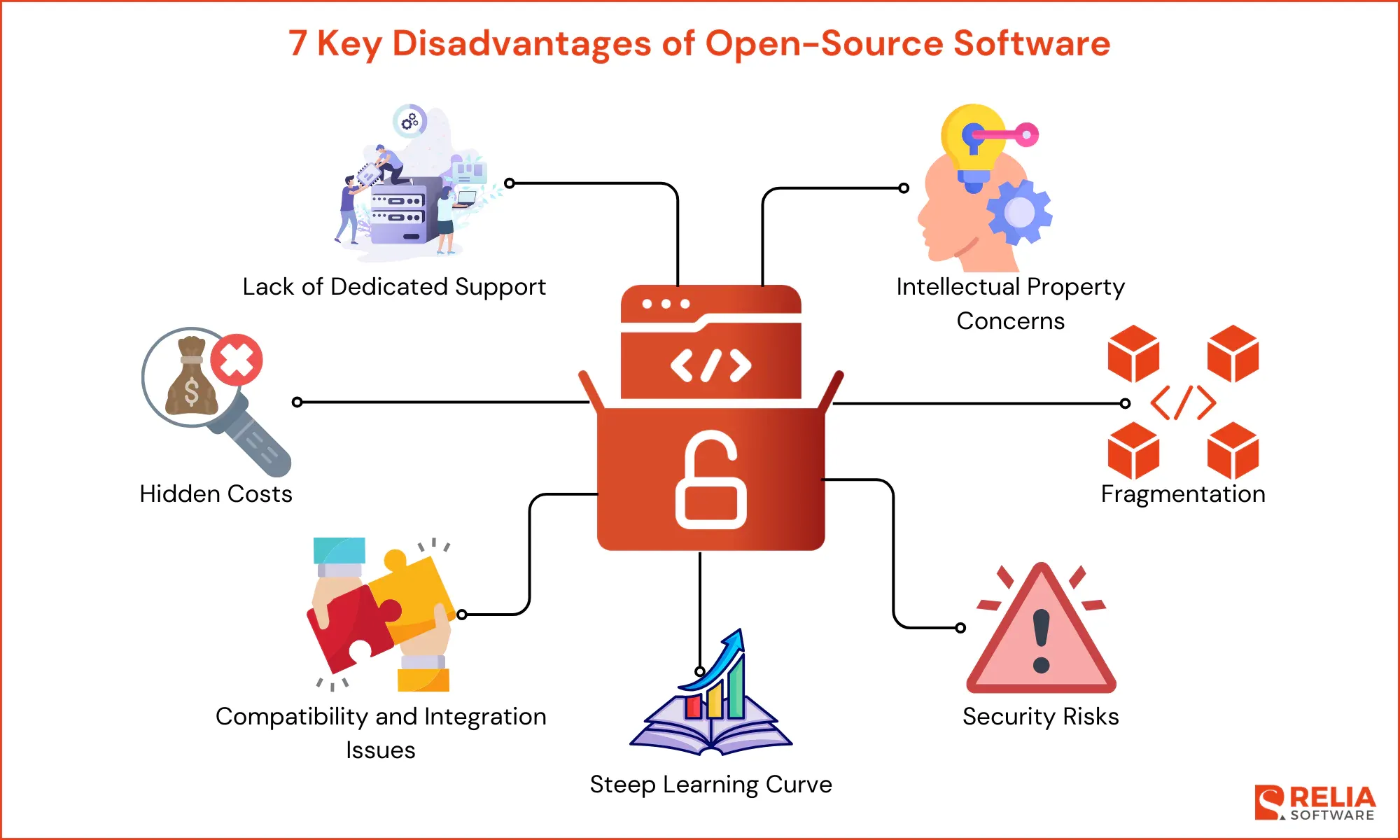Do you feel stuck by the limitations of traditional software? Open-source might be the breath of fresh air you're looking for. With the freedom to modify, improve, and share, it's a game-changer for developers and businesses alike.
But while the benefits of collaboration and cost-efficiency are appealing, open-source comes with its own set of challenges. Before jumping in, it's important to weigh the advantages and disadvantages to see if it aligns with your goals. Let’s take a closer look at what open-source software can offer and the potential pitfalls you should be aware of.
>> Read more: Unlock the Difference between Open-Source and Proprietary Software
What is Open-Source Software (OSS)?
Open-source software (OSS) refers to software whose source code is openly available to the public, allowing anyone to view, modify, and distribute it. Unlike proprietary software, where the code is restricted and controlled by a single entity, OSS promotes transparency and collaboration by encouraging contributions from a global community of developers.
The core principles of OSS are freedom (users have control over the software), collaboration (development is a community-driven process), and transparency (anyone can inspect the code for security or improvements).
Over the past few decades, open-source software has rapidly grown in popularity. Major platforms like Linux, Kubernetes, and WordPress, as well as companies like Google and Microsoft, have adopted OSS to enhance their operations. With continuous input from the global developer community, OSS remains a driving force in software innovation, powering solutions across various industries and keeping modern development agile and collaborative.
>> Read more:
- Top 20 Open-Source Unit Testing Frameworks For Developers
- Top 10 Best Open Source React & React Native IDEs
- Top 20 Infrastructure as Code (IaC) Tools For Businesses
6 Key Advantages of Open-Source Software
Cost-Effectiveness
Open-source software (OSS) provides a significant financial benefit because most tools are free to download and use. This eliminates the need for costly licensing fees, making it particularly attractive for small businesses and startups. The savings can be redirected to other important areas like hiring or marketing.
In addition to being cost-effective upfront, OSS reduces ongoing costs through free community-driven support. While there may be some investment in training or customization, these costs are much lower than the long-term licensing, maintenance, and upgrade costs of proprietary software.
Finally, OSS often has more efficient resource utilization, allowing organizations to run it on less powerful hardware. This can reduce the need for costly upgrades and saving on server and energy expenses.
Flexibility and Customization
One of the most attractive features of OSS is the ability to customize it to fit unique business needs. With full access to the source code, developers can easily modify the software to align with specific requirements, something that’s hard to achieve with proprietary options. This means businesses can add new features, fine-tune existing ones, or remove unnecessary components to create a solution that perfectly matches their workflows.
This flexibility also allows companies to adapt quickly to changes in technology or market demands, giving them the freedom to innovate on their own schedule without being tied to vendor updates.
Community and Collaboration
Open-source software thrives on collaboration within a global community of developers, creating an environment where innovation moves quickly. With many contributors, issues are identified and resolved quickly, and new features are added continuously, pushing constant improvements.
For developers, contributing to OSS is an opportunity to learn, enhance their skills, and gain recognition in the tech world. Businesses benefit from this vibrant collaboration by gaining access to the latest technologies and solutions. Projects like Linux, Kubernetes, and MySQL have become reliable and efficient due to the collaborative efforts of the open-source community, driving forward innovation that benefits everyone involved.
Transparency and Security
Open-source software is transparent by design, with its code open to public inspection. This allows for quicker identification and resolution of security vulnerabilities compared to proprietary software, where users rely solely on the vendor to detect and address issues. The open-source community acts like a collective security team, regularly releasing patches and updates at a faster pace.
For businesses handling sensitive data, this transparency is crucial for ensuring that any security risks are swiftly addressed, providing greater peace of mind.
>> You may be interested in:
- Top 14 Best Data Security Software For Your Businesses
- Top 7 Web App Security Testing Tools For Developers
Scalability
OSS is inherently scalable, making it suitable for businesses of all sizes. It can adapt to meet current needs and grow as the business expands. For example, platforms like Kubernetes allow for large-scale operations, ideal for managing fluctuating workloads and long-term growth.
The modular nature of OSS lets businesses expand components as needed, without requiring expensive upgrades or new systems, unlike many proprietary solutions. This ensures businesses can scale without limitations.
Vendor Lock-In Avoidance
Open-source software frees businesses from dependency on a single vendor. With OSS, businesses have full control over their technology stack, ensuring smoother transitions and reducing the risks associated with vendor-imposed restrictions.
Additionally, OSS increases leverage when negotiating with other vendors for additional services. Since businesses aren't locked into one provider, they gain more bargaining power. Lastly, because open-source projects are less likely to be abandoned, companies avoid the risks of relying on software that could be discontinued or unsupported by vendors.

7 Key Disadvantages of Open-Source Software
Lack of Dedicated Support
Open-source software (OSS) often lacks professional, dedicated support teams. While community forums and contributors may offer help, the lack of a guaranteed response or immediate assistance can be a challenge, particularly during critical situations. In contrast, proprietary software typically comes with customer support services, which can be crucial for maintaining smooth business operations.
Hidden Costs
Although OSS is typically free to download and use, there can be hidden costs that businesses need to consider. For example, companies may need to spend on training employees, customizing the software, or hiring developers to maintain and update the system. If internal teams aren't familiar with the OSS tool, businesses often pay for third-party support services for more mission-critical applications, potentially raising operational expenses.
Compatibility and Integration Issues
OSS projects can sometimes lead to compatibility issues when integrating with other systems or software. Many open-source tools are built independently, and some may not work seamlessly with existing proprietary solutions. This can require additional development effort to ensure smooth integration, which can delay implementation and increase project costs.
Steep Learning Curve
Open-source software may come with a steeper learning curve, especially for users who are accustomed to user-friendly, proprietary alternatives. OSS often lacks the polished user interfaces and comprehensive documentation found in paid software, which can make it harder for less technical users to adopt and use effectively. This learning curve can lead to increased training costs and longer onboarding times for teams.
Security Risks
While OSS transparency allows for faster identification of vulnerabilities, it also exposes the software to potential risks. Because the source code is available to everyone, malicious users can exploit weaknesses if they aren’t patched quickly enough. Unlike proprietary software, where vendors often have strict security protocols, OSS security is largely dependent on community vigilance, which may not always be reliable or immediate.
Fragmentation
The decentralized nature of OSS can lead to fragmentation, where different versions or forks of the software are created. This can make it challenging for businesses to choose the right version or ensure long-term support and development. Fragmentation also creates issues with compatibility, documentation, and community support, leading to inconsistent user experiences.
Intellectual Property Concerns
Intellectual property (IP) concerns are a key issue when using open-source software, especially for businesses that integrate it into their proprietary solutions. Some open-source licenses, like the GNU General Public License (GPL), require that any modified or derivative work must also be released as open source. This can create conflicts for companies that want to keep their software proprietary.
It’s essential for businesses to thoroughly review the terms of the licenses for any OSS they use. Misinterpreting or ignoring these terms can lead to legal complications, including lawsuits or the obligation to open-source parts of proprietary code.
To avoid such risks, companies must fully understand the legal obligations that come with using and modifying OSS. Non-compliance with these licenses can expose businesses to serious legal and financial consequences.

Ideal Scenarios for Using Open-Source Software
Open-source software (OSS) can be highly effective in several scenarios, depending on a company's needs, budget, and technical expertise. Here are some ideal use cases for OSS:
Startups and Small Businesses with Limited Budgets
Open-source software is perfect for businesses looking to minimize expenses. Startups and small companies with tight budgets can avoid high licensing fees and leverage free or low-cost OSS solutions. Examples include using Linux-based operating systems, free content management systems like WordPress, or cloud infrastructure tools like Kubernetes.
Educational Institutions
OSS is widely used in educational settings due to its cost-effectiveness and accessibility. Schools and universities can use free tools for learning environments, coding platforms, and software development courses. OSS encourages students to explore, learn, and contribute to real-world projects, fostering deeper understanding and hands-on experience.
Example: A university can use the open-source Jupyter Notebook for data science and machine learning courses, allowing students to experiment and learn interactively.
Development and Innovation-Focused Environments
In companies or environments where innovation and rapid development are key, OSS can accelerate project timelines. Open-source tools are often built and improved collaboratively, allowing for faster bug fixes, feature additions, and performance improvements. For example, a tech company working on artificial intelligence can use the open-source TensorFlow or PyTorch framework to build and train machine learning models efficiently.
>> Read more:
- Top 9 Best Deep Learning Frameworks for Developers
- Top 9 Machine Learning Platforms for Developers in 2024
Customization-Heavy Projects
Businesses that need specific, tailor-made software solutions can benefit from the flexibility of OSS. This is especially useful in industries like healthcare and finance where customized solutions are often required to meet regulatory standards or unique operational workflows.
For example, a healthcare provider can use OpenMRS to create a customized medical record system that adheres to local regulations and operational workflows.
Large Enterprises with In-House IT Teams
Large enterprises with dedicated IT and development teams can benefit from OSS by customizing it to their large-scale needs. For instance, companies like Google and Facebook extensively use and contribute to OSS because it allows them to innovate faster and build infrastructure that supports their massive data needs.
Collaborative Research and Development
Open-source software is ideal for industries that rely on collaboration, such as research institutions, non-profits, or open science projects. These environments require transparent, adaptable tools to enable collaboration across institutions and borders, and OSS fosters community-driven innovation.
For example, a group of scientists can use the open-source GitHub platform to collaborate on research projects and share their findings with the broader scientific community.
Cloud and DevOps
OSS is highly popular in cloud computing and DevOps workflows. Tools like Docker, Kubernetes, and Jenkins are open-source, and they help companies streamline their deployment processes, manage infrastructure, and scale applications efficiently. OSS in cloud environments provides the flexibility to scale as needed while avoiding vendor lock-in.
Example: A software company can use Docker to containerize its applications, making it easier to deploy and manage across cloud environments, enhancing scalability and flexibility.
FAQs
-
How can organizations ensure the quality and reliability of open-source software they adopt? Organizations can evaluate the project's community size, activity level, and code quality. They can also consider using reputable vendors or managed services.
-
In what ways can the transparency of open-source software contribute to its overall security and reliability? Transparency allows for easier identification and patching of vulnerabilities. Additionally, the large number of eyes on the code often helps to uncover potential security issues.
-
What are the factors that contribute to the success or failure of an open-source project? Factors include strong community involvement, active maintainers, clear governance, and a well-defined roadmap.
-
How can individuals and organizations contribute to the open-source community and promote its growth? Individuals can contribute by coding, testing, documenting, or providing feedback. Organizations can support open-source projects through funding, sponsorship, or by hiring open-source developers.
-
What types of industries benefit the most from open-source software, and why? Technology, education, government, and healthcare are industries benefiting the most from open-source software (OSS). The tech sector uses OSS for flexibility and rapid innovation, schools for cost-effective learning tools, governments for transparency and cost savings, and healthcare for customized, regulatory-compliant systems.
>> Read more: Off-the-Shelf Software vs Custom Software: Which to Choose?
Conclusion
Open-source software is a strong alternative to proprietary solutions, offering key advantages like cost savings, flexibility, community-driven support, transparency, and rapid innovation. However, it's important to also consider potential challenges, such as security risks, complex licensing terms, and potential integration issues.
By weighing both the benefits and risks, organizations can decide if open-source software aligns with their goals and technical requirements. This balanced approach helps ensure that the chosen software meets the specific needs of the business while minimizing risks.
>>> Follow and Contact Relia Software for more information!
- Mobile App Development
- development

